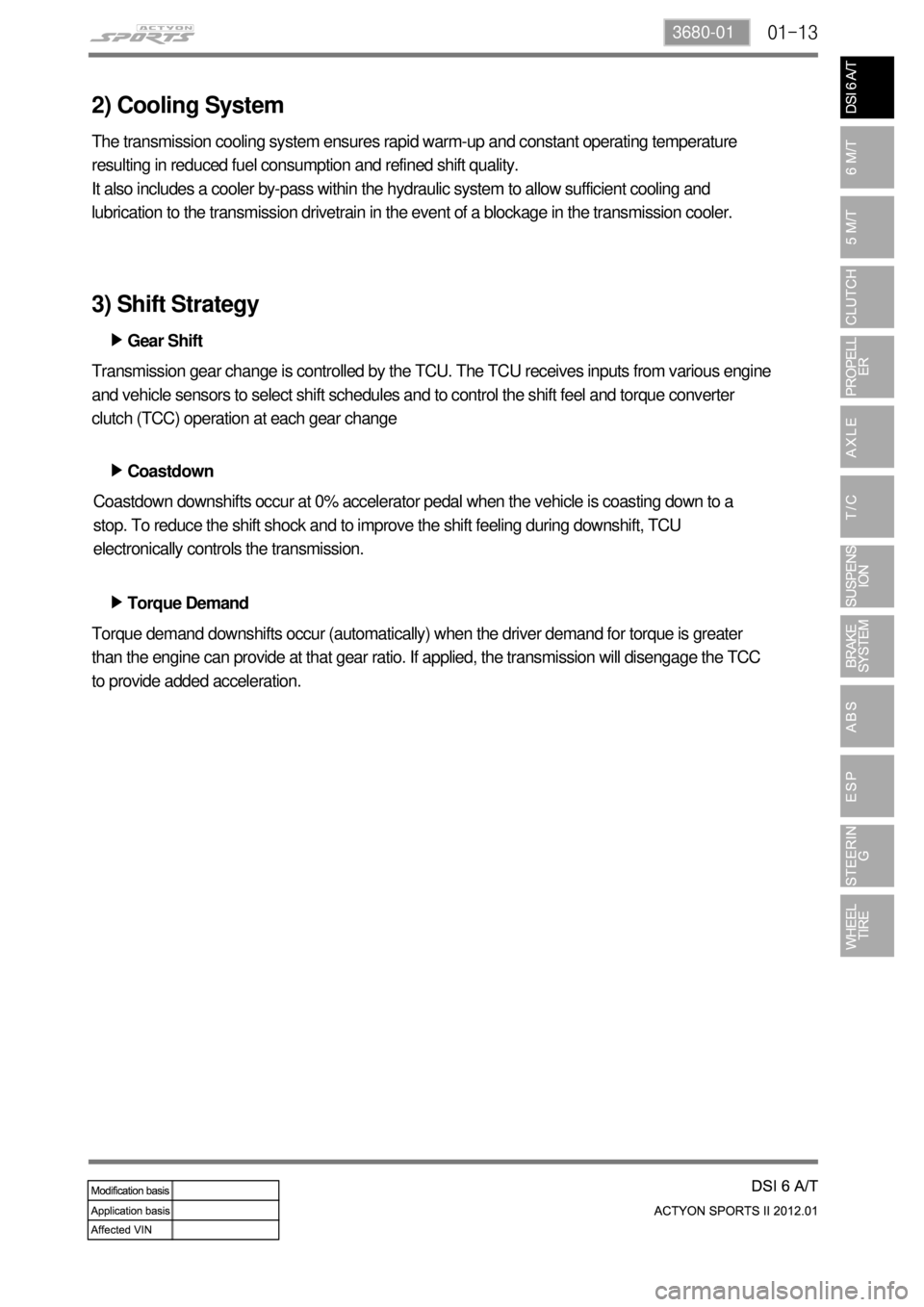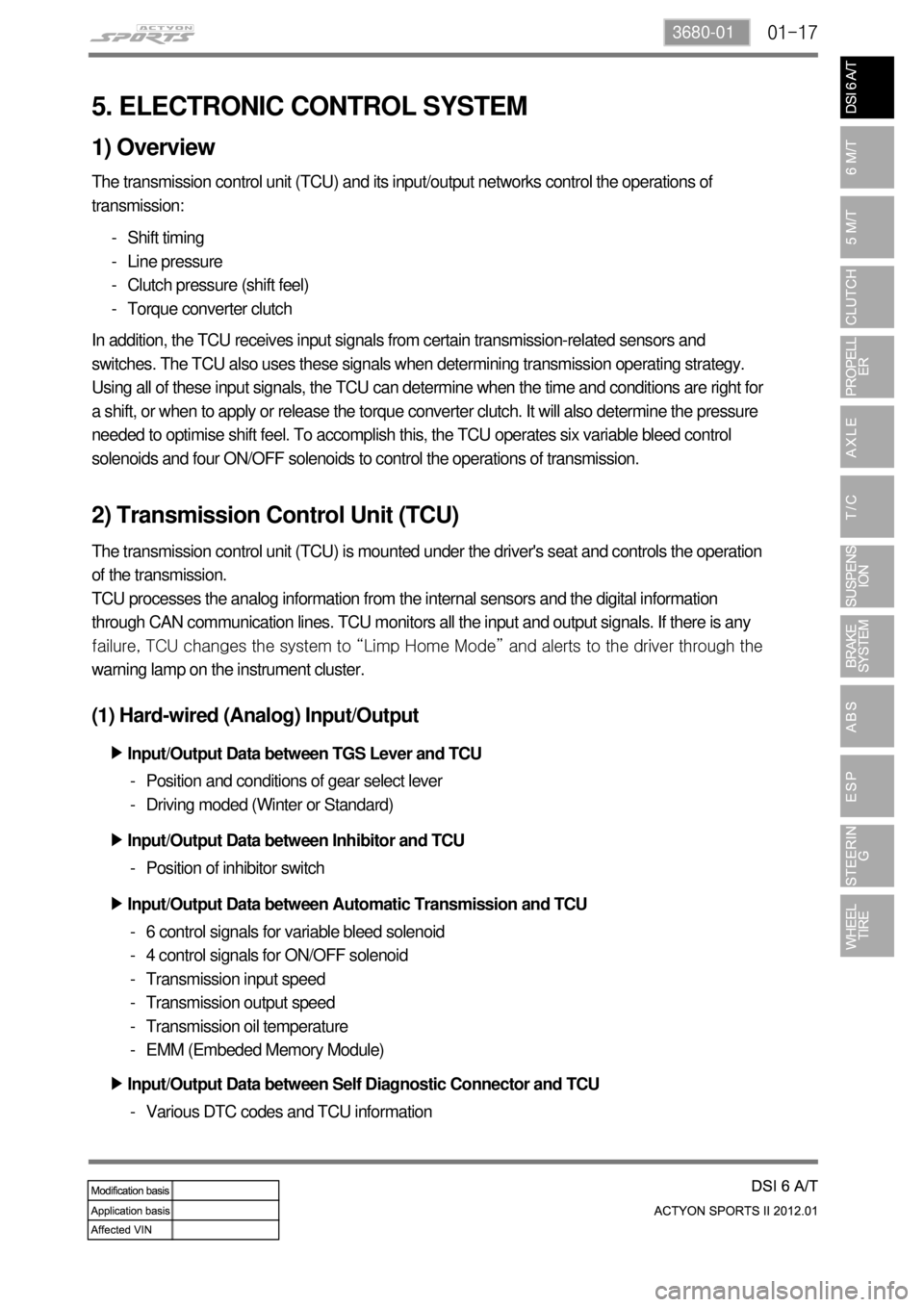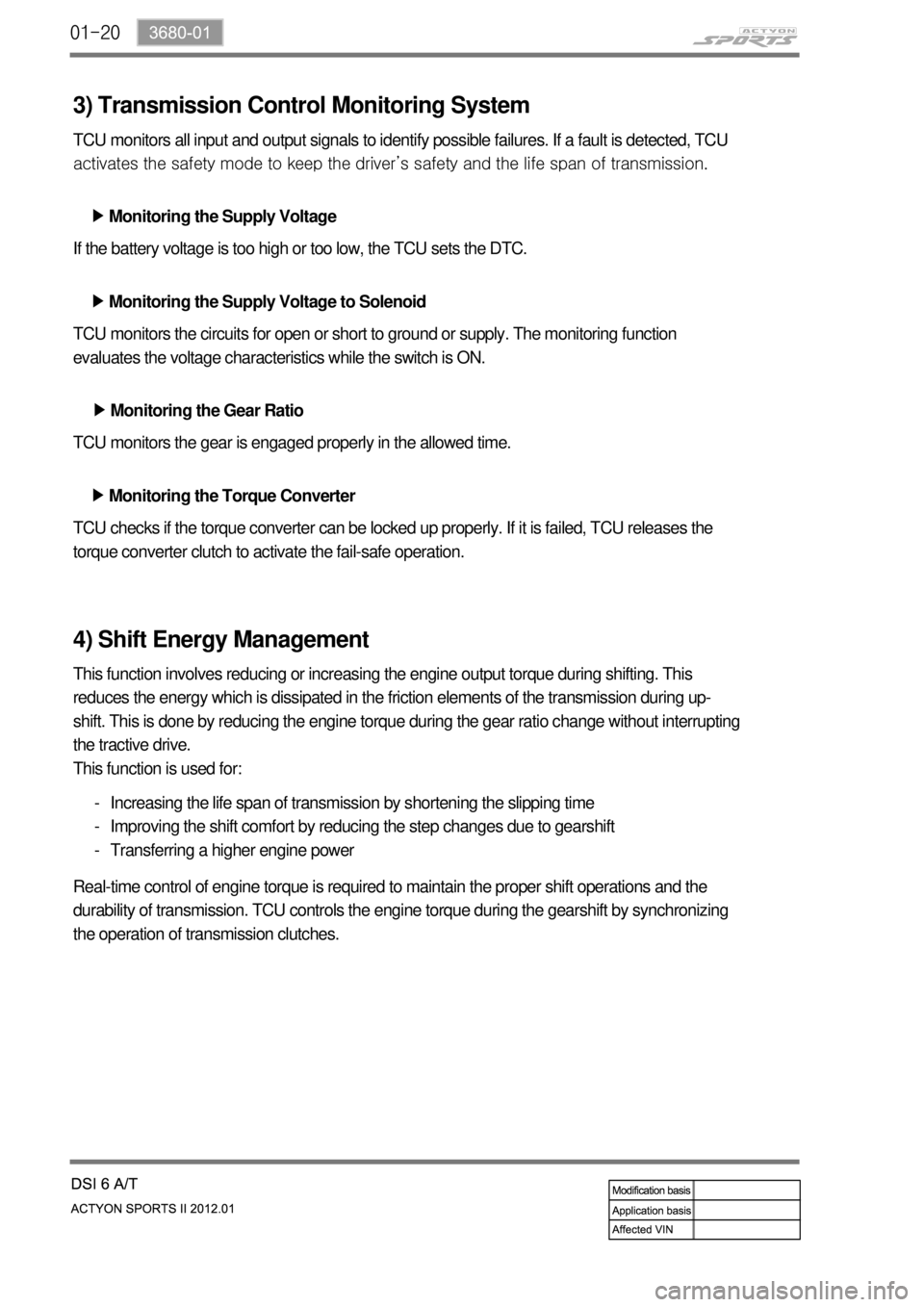Page 406 of 828
12-118510-23
5) Normal Cancellation of the Cruise Control
The cruise control system will be canceled when one or more items of the following conditions
are applied;
When the brake pedal is depressed or When ESP is activated.
When the cruising speed is downed less than 34 km/h
When applying the parking brake during driving.
When using the clutch in order to shift (M/T only). 1.
2.
3.
4.
Keep the main cruise control switch in the neutral position when not using the cruise control.
Page 547 of 828

01-33680-01
1. GENERAL INFORMATION
Six forward speeds
One reverse gear
A toruqe converter with an integral converter
lock-up clutch
Electronic shift and pressure controls
A single planetary gear-set
A double planetary gear-set
Two hydraulically controlled brake bands
Three multi-plate clutches
All hydraulic functions are directed by
electronic solenoids to control -
-
-
-
-
-
-
-
- Automatic transaxle (DSI M78) ▶
TCU ▶
TCU is located under the driver's seat and controls the operations of transmission.
TCU receives the ignition voltage and has three connectors (16-pin, 12-pin, 20-pin).
TCU receives input signals from certain transmission-related sensors, gear select lever and
inhibitor switch. TCU also uses these signals when determining transmission operating strategy.
TCU uses PCAN to communicate with other units. And, TCU communicates with engine ECU,
ESP unit, TCCU and instrument cluster through CAN lines to control the gear shifting and to
recognize the current gear position.
DSI M78 Automatic Transmission is based on the transmission in the vehicle with D20DT engine
for EURO III or EURO IV or EURO V.
Differences: changed some components (torque converter and torque converter housing, some
pinion gears, sun gear), increased torsional damping force.
TCU
Page 552 of 828
01-8
4WD
2WD
3) Sectional Diagram
Fluid pumpClutch pack
Double planetary
gear-set
Torque converter Valve body
Fluid pumpSingle planetary
gear-set
Clutch pack
Torque converter Valve body
Single planetary
gear-setDouble planetary
gear-set
Page 555 of 828

01-113680-01
1. OVERVIEW
The six speed automatic (M78) transmission
is available in two variants: four wheel drive
and two wheel drive.
The transmission has the following features:
Six Forward Speeds
One reverse gear
A torque converter with an integral converter lock-up clutch
Electronic shift and pressure controls
A single planetary gear-set
A double planetary gear-set
Two hydraulically controlled brake bands
Three multi-plate clutches
All hydraulic functions are directed by electronic solenoids to control: -
-
-
-
-
-
-
-
-
Engagement feel
Shift feel
Shift scheduling
Modulated torque converter clutch applications ·
·
·
·
The transmission contains fully synthetic automatic transmission fluid (ATF) and is filled for life;
therefore it does not require periodic servicing.
Engine power reaches the transmission via a torque converter with integral converter lock-up
clutch.
The six forward gears and one reverse gear are obtained from a single planetary set, followed by
a double planetary set. This type of gear-set arrangement is commonly known as Lepelletier type
gear-set.
The automatic transmission is electronically controlled. The control system is comprised of the
following elements:
External transmission control unit (TCU)
Internal embedded memory module (EMM)
Input and output speed sensors
Valve body unit comprised of four on/off solenoid valves and six variable bleed solenoids
Torque converter -
-
-
-
-
Page 556 of 828

01-12
2. FEATURES
Early Downshifts with Hard Braking and Skip Shifts ▶
When heavy braking is detected, the transmission downshifts early and skips gears to provide
increased engine braking to provide gear selection for tip-in.
Gear Hold on Uphill/Downhill ▶
If the accelerator pedal is released when travelling uphill, upshifts are prevented to reduce
busyness on grades. If the accelerator pedal is released when travelling downhill, upshifts are
prevented to enhance engine braking.
Soft Engagement when Shifting to “D” and “R” Position ▶
A soft engagement feature avoids harsh take up of drive when selecting Drive or Reverse. This is
achieved by limiting engine speed and engine torque which results in a rapid, but progressive
engagement of either Drive or Reverse when moving from the Park or Neutral positions. There is
no drive engagement prevention strategy implemented on the transmission system as there is
sufficient engine strategy to protect the system. However, reverse gear engagement is prevented
until engine speed is less than 1400 rpm and the accelerator pedal position is less than 12% and
vehicle speed is less than 10 km/h.
Converter Clutch Lock-Up In All Gears ▶
The transmission features converter clutch lock-up in all gears. This feature provides improved
fuel economy and vehicle performance. It also improves transmission cooling efficiency when
towing heavy loads at low speeds, e.g. in city driving or hill terrain.
Embeded Memory Module (EMM) ▶
The embedded memory module (EMM) is
matched to the transmission's valve bodies
during transmission assembly to ensure
refined shift quality. The EMM is integrated
into the input speed sensor which is mounted
on the valve body in the transmission. The
EMM is used to store data such as valve body
calibration data and valve body serial number.
Upon installation, the TCU will download the
data from the EMM and utilise this data in the
operation of the transmission.
1) Features
Page 557 of 828

01-133680-01
2) Cooling System
The transmission cooling system ensures rapid warm-up and constant operating temperature
resulting in reduced fuel consumption and refined shift quality.
It also includes a cooler by-pass within the hydraulic system to allow sufficient cooling and
lubrication to the transmission drivetrain in the event of a blockage in the transmission cooler.
Gear Shift ▶
Coastdown ▶
Torque Demand ▶ Transmission gear change is controlled by the TCU. The TCU receives inputs from various engine
and vehicle sensors to select shift schedules and to control the shift feel and torque converter
clutch (TCC) operation at each gear change
Coastdown downshifts occur at 0% accelerator pedal when the vehicle is coasting down to a
stop. To reduce the shift shock and to improve the shift feeling during downshift, TCU
electronically controls the transmission.
Torque demand downshifts occur (automatically) when the driver demand for torque is greater
than the engine can provide at that gear ratio. If applied, the transmission will disengage the TCC
to provide added acceleration.
3) Shift Strategy
Page 561 of 828

01-173680-01
5. ELECTRONIC CONTROL SYSTEM
1) Overview
The transmission control unit (TCU) and its input/output networks control the operations of
transmission:
Shift timing
Line pressure
Clutch pressure (shift feel)
Torque converter clutch -
-
-
-
In addition, the TCU receives input signals from certain transmission-related sensors and
switches. The TCU also uses these signals when determining transmission operating strategy.
Using all of these input signals, the TCU can determine when the time and conditions are right for
a shift, or when to apply or release the torque converter clutch. It will also determine the pressure
needed to optimise shift feel. To accomplish this, the TCU operates six variable bleed control
solenoids and four ON/OFF solenoids to control the operations of transmission.
2) Transmission Control Unit (TCU)
The transmission control unit (TCU) is mounted under the driver's seat and controls the operation
of the transmission.
TCU processes the analog information from the internal sensors and the digital information
through CAN communication lines. TCU monitors all the input and output signals. If there is any
<008d008800900093009c0099008c00530047007b006a007c0047008a008f00880095008e008c009a0047009b008f008c0047009a00a0009a009b008c00940047009b0096004702c800730090009400970047006f00960094008c004700740096008b008c02
c9004700880095008b004700880093008c0099009b009a0047>to the driver through the
warning lamp on the instrument cluster.
(1) Hard-wired (Analog) Input/Output
Input/Output Data between TGS Lever and TCU ▶
Position and conditions of gear select lever
Driving moded (Winter or Standard) -
-
Position of inhibitor switch - Input/Output Data between Inhibitor and TCU ▶
6 control signals for variable bleed solenoid
4 control signals for ON/OFF solenoid
Transmission input speed
Transmission output speed
Transmission oil temperature
EMM (Embeded Memory Module) -
-
-
-
-
- Input/Output Data between Automatic Transmission and TCU ▶
Input/Output Data between Self Diagnostic Connector and TCU ▶
Various DTC codes and TCU information -
Page 564 of 828

01-20
3) Transmission Control Monitoring System
TCU monitors all input and output signals to identify possible failures. If a fault is detected, TCU
<0088008a009b0090009d0088009b008c009a0047009b008f008c0047009a0088008d008c009b00a0004700940096008b008c0047009b009600470092008c008c00970047009b008f008c0047008b00990090009d008c009902c5009a0047009a0088008d00
8c009b00a0004700880095008b0047009b008f008c00470093>ife span of transmission.
Monitoring the Supply Voltage ▶
Monitoring the Supply Voltage to Solenoid ▶
Monitoring the Gear Ratio ▶
Monitoring the Torque Converter ▶ If the battery voltage is too high or too low, the TCU sets the DTC.
TCU monitors the circuits for open or short to ground or supply. The monitoring function
evaluates the voltage characteristics while the switch is ON.
TCU monitors the gear is engaged properly in the allowed time.
TCU checks if the torque converter can be locked up properly. If it is failed, TCU releases the
torque converter clutch to activate the fail-safe operation.
4) Shift Energy Management
This function involves reducing or increasing the engine output torque during shifting. This
reduces the energy which is dissipated in the friction elements of the transmission during up-
shift. This is done by reducing the engine torque during the gear ratio change without interrupting
the tractive drive.
This function is used for:
Increasing the life span of transmission by shortening the slipping time
Improving the shift comfort by reducing the step changes due to gearshift
Transferring a higher engine power -
-
-
Real-time control of engine torque is required to maintain the proper shift operations and the
durability of transmission. TCU controls the engine torque during the gearshift by synchronizing
the operation of transmission clutches.